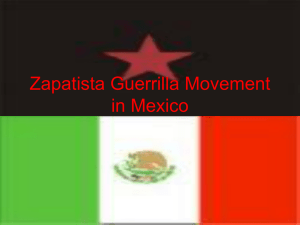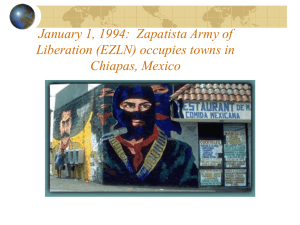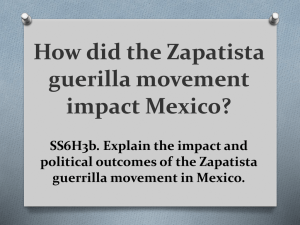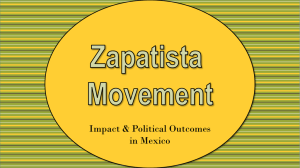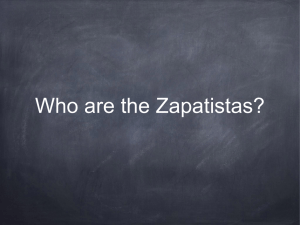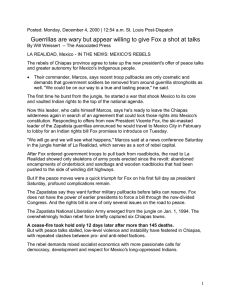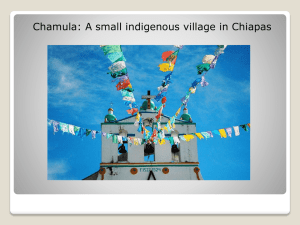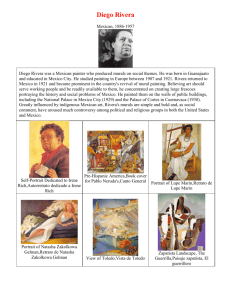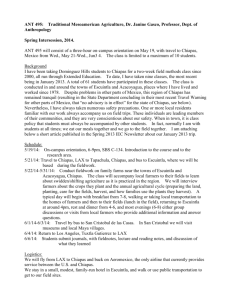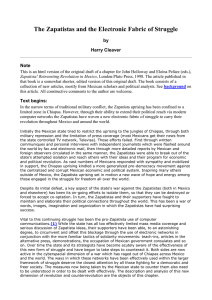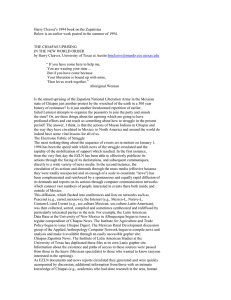Zapatista overview – Corrido lesson plan SFC
advertisement
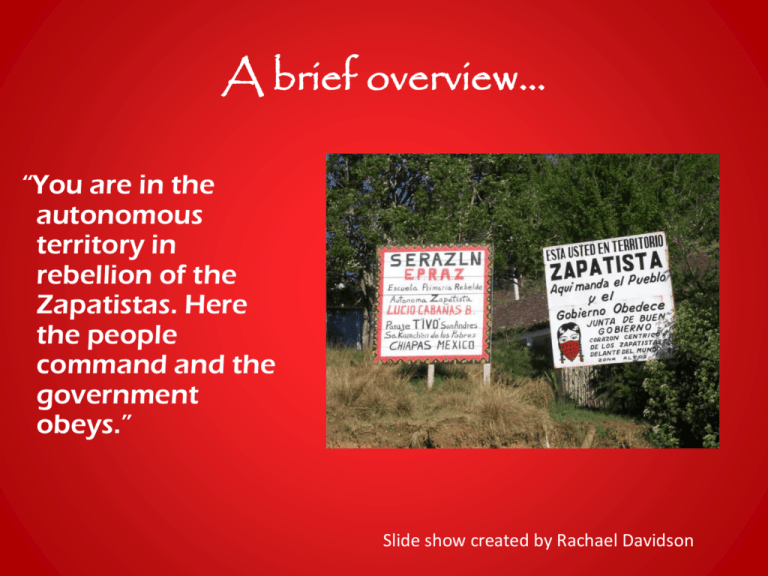
A brief overview… “You are in the autonomous territory in rebellion of the Zapatistas. Here the people command and the government obeys.” Slide show created by Rachael Davidson January 1, 1994 • The Zapatistas began their rebellion with a number of specific list of 11 demands: work, land, housing, food, health care, education, independence, freedom, democracy, justice, and peace. • The First Declaration from the Lacandon Jungle, issued on January 2, 1994, opens with the statement, "We are the product of 500 years of struggle." In addition, on that same date the Zapatistas issued a law about women's rights. • Over the last few years the demands and vision of the movement has deepened and matured. The most complete statement of their current position is available in a document known as The Sixth Declaration of the Lacandon Jungle. (Schools for Chiapas – www.schoolsforchiapas.org) Behind our black mask, Behind our armed voice, Behind our unnameable name, Behind us, who you see, Behind us, we are you. Behind us, you are us. Behind our masks is the face of all excluded women, Of all the forgotten individuals, Of all the persecuted homosexuals, Of all the despised youth, Of all the beaten migrants, Of all those imprisoned for their words and thoughts, Of all the humiliated workers, Of all those dead from neglect, Of all the simple and ordinary men and women, Who don’t count, Who aren’t seen, Who are nameless, Who have no tomorrow. ¿Dondé esta Chiapas? Where is Chiapas? Chiapas located in the most Southeastern region of Mexico bordering Guatemala. Chiapas is ecologically diverse ranging from a 156 mile coastline, tropical rainforest, Sierra Madre mountain range, and highlands mountainous regions known as “Los Altos.” “Poor People, Rich State” • Largest generator of hydroelectricity (55% of total production of Mexico) • Oil and Gas • 156 miles of coastline • Timber • In the last 40 years Chiapas has lost 70% of its natural resources • Chiapas: 73,724 square kilometers • Population 3.5 million The population of Chiapas constitutes three per cent of the national population. • Languages: Mayan – Ch’ol – Lancandon – Tzeltal – Tzotzil – Tojolabal – Zoque – Mam – Kanjobal Two Tojolabal women in traditional dress, La Realidad, Chiapas, Mexico. (Schools for Chiapas) Autonomous Zapatista Zones http://www.counterpunch.org/wp-content/dropzone/2014/01/best-map.jpg La Lucha para la Tierra y la Libertad The struggle for Land and Liberty •History of 500 years of resistance in Mexico •Slavery •Invasion of Spain •North American expansion •Expelling of the French Empire •dictatorship of Porfirio Diaz (PRI) •North American Free Trade Agreement (NAFTA) Emiliano Zapata • (1879 – 1919) • The Zapatista National Liberation Army took its name from Emiliano Zapata, a hero of the 1910-1917 Mexican Revolution, who fought for "Land and Liberty." • http://www.culturalsurvival.org/publications/cultural-survival-quarterly/mexico/ecology-zapatistarevolt#sthash.k7WCLObg.dpuf The Two Sides of NAFTA • “Farmers in the United States, Canada, and Mexico all benefit from NAFTA.” (fas.usda.gov) • “NAFTA is a death sentence for the indigenous people.” “Whose Idea of Progress?” • NAFTA promised progress to rural farmers - how can indigenous farmers benefit if they cannot compete? • "With the highways have come the war tanks, the cannons, soldiers, prostitution, venereal diseases, alcoholism, rapes of indigenous women and children, death and misery." http://www.csuchico.edu/zapatist/HTML/Archive/Communiques/marcos_amador_courage_aug.html • “Indigenous people of Mexico have never had the freedom of expressionto set price for goods – the buyer sets the price – this is where the exploitation begins.” Las Personas Desplazadas The Displaced People • 13,000 people estimated displaced in at least 20 municipalities in Chiapas (2003) • The indigenous population of Mexico approx. 17.8 million persons, has suffered the greatest internal displacement in Chiapas Causes of displacement International Displacement Project report: • • • • 1994 Zapatista uprising conflict between Mexican military and the EZLN 1997 Acteal massacre ongoing harassments by paramilitary, government and armed civilians Human rights observers report: • • • • paramilitary activity armed conflict violation of human rights land disputes Bottom photo by R. Davidson Revolutionary Women’s Law Women have the right to….. •Participate in revolutionary struggle •Work and recieve a fair salary •Decide number of children to bear and care for •Hold positions of authority if freely and democratically elected •Primary to health care •Education •Choose their partner and cannot be forced to marry not be beaten or physically mistreated by family or strangers •Occupy positions of leadership and hold military ranks •All rights and obligations elaborated in the revolutionary laws and regulations. “We do not need to change our culture, our clothing, our language, our way of prayer, our way of working and respecting the land, we cannot stop being indigenous in order to be recognized as Mexicans.” Comandante Esther August 9, 2003 Photo by R. Davidson La Resistencia – Creating Change • Civilian Zapatista Centers (Caracoles) • Autonomous Education • Health clinics • Women’s cooperatives • Collective farming ZapatistaHealth Care • Provides health care to Zapatista communities • Pharmacy stocked with western medicine and natural herbs grown on site • Majority of illnesses are poverty-related and preventable through vaccination and sanitary measures Education • ESRAZ – Escuela Secundaria Rebelde Autonomía Zapatista • Promotores y promotoras – education is recipricol between students and teachers - • Focus of education - preserve culture, language, & way of life • Students – often times students stay in dorms for periodsof time during year – travel long distances on foot • International Support Democracy Now! Report from Chiapas 20 years later (1994-2014) • http://www.youtube.com/watch?v=pTzC_QqS qwc Music - Corridos • “Corridos spring from a long Mexican tradition of political and satirical music broadly diffused during the early 20th century Mexican revolution led by Emiliano Zapata. Corridos are the most revolutionary of musical styles within the contemporary Zapatista movement. This quintessential Mexican music is played at community festivals, on the ubiquitous Zapatista pirate radio stations, and within Mexican and international solidarity circles. A guitar or accordion provides the lead melody line accompanied by a bass and rhythm guitar joined with two to four part vocal harmonies. Mexican Corridos tell a story in the form of a song often celebrating key dates and individuals within the social movements. The passions of the 1994 insurrection sparked an explosion of songwriting in the corrido form that continues today ~ especially in autonomous Mayan communities.” http://www.schoolsforchiapas.org/english/store/catalog/896.html http://www.schoolsforchiapas.org/assets/catalog/902/harp_guitar.jpg La Conquista por Grupo Liberación Soy Chiapaneco Y soy Zapatista Tengo el orgullo De ser de Aquí Los pueblos Mayas Y su cultura Fueron destruidos Por la invasión Soy descendiente Del pueblo Maya Raza bendita De mi nación Los españoles Conquistadores Esclavizaron A la nación Quiero contarles Nuestra historia Quiero contarles De la Nación Tres cientos años De ser esclavos Cuando Hidalgo Se levantó Lo que ha pasado En aquellos años Cuando vinieron A conquistar Lleva los indios A luchar Por independencia Y por libertad En quinientos años No se terminan Esta injusticia Y la maldad Los pueblos Mayas Viven injusticia Hambre, miseria Y enfermedad Somos Tzotziles Y Tojolabales Somos Tzeltales Y Chol también Soy Chiapaneco Y soy Zapatista Tengo el orgullo De ser de aquí Soy descendiente Del pueblo Maya Raza bendita De la nación for more information / additional resources Zapatistas • http://enlacezapatista.ezln.org.mx/ • www.schoolsforchiapas.org • http://www.seattleglobaljustice.org/2014/01/nafta-zapatista-uprising-20years/ • www.mexicosolidarity.org • www.revistarebeldia.org Corridos: • http://www.corridos.org/ • With His Pistol in His Hand: A border ballad and its hero by Américo Paredes. (University of Texas Press, 1998.) • http://www.schoolsforchiapas.org/english/projects/schools-ofhope/mayan-music.html Photos: • • • • • www.schoolsforchiapas.org www.fzln.org.mx www.ciepac.org www.axisoflogic.com Personal collection – R. Davidson
